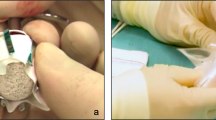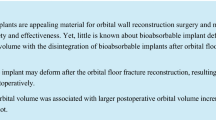Summary
Background: To compensate the orbital volume deficit after enucleation orbital implants are used.
Method: Between 1986 and 1996, 449 enucleations were performed. One hundred and fifty-five orbital implants were used: 96 hydroxylapatite-ceramic-silicon (HAK-silicon), 29 hydroxylapatite-ceramic (HAK), 26 Kiel bone chips, 3 Walser and 1 Bangerter implant.
Results: Ten orbital implants (6.45 %) had to be explanted. Seven of the 96 HAK-silicon implants were explanted: four could be changed, two of them with a smaller and two with a same diameter. We observed a complication rate of 7.29 % and a rate of total loss of 3.13 %. One luxated HAK-implant could be refixated (3.45 %), and one implant (3.85 %) of the Kiel bone chip implants was explanted.
Conclusion: Using different types of orbital implants after enucleation, we observed a complication rate of 7 %. However, to avoid the post-enucleation-syndrome and to achieve better motility of the prosthesis, orbital implants should be used.
Zusammenfassung
Hintergrund: Zur Kompensation des Orbitavolumendefizits, zur Vermeidung des Post-Enukleations-Syndroms, sowie der Verbesserung der Prothesenmotilität werden nach durchgeführter Enukleation Orbitaimplantate verwendet.
Patienten und Methode:Über einen Zeitraum von 10 Jahren wurden von 1986–1996 in der Universitäts-Augenklinik Hamburg bei 449 Enukleationen insgesamt 155 Orbitaimplantate eingesetzt, davon 96 × ein Hydroxyl-Apatit-Keramik-Silikon-, 29 × ein Hydroxyl-Apatit-Keramik- (HAK), 26 × ein Kieler Knochenspan-, 3 × ein Walser-, sowie 1 × ein Bangerter-Implantat.
Ergebnisse: Insgesamt mußten 10 Orbitaimplantate (6,45 %) wieder entfernt werden. Ausgehend von 96 HAK-Silikon-Implantaten wurden 7 Implantate entfernt, davon konnten 4 durch ein gleichartiges Implantat mit 2 × kleinerem und 2 × gleichem Durchmesser ersetzt werden, was einer Komplikationsrate von 7,29 % und einer Verlustrate von 3,13 % entspricht. Von den 29 HAK-Implantaten konnte 1 luxiertes (3,45 %) neu fixiert werden, während von 26 Kieler Knochenspan-Implantaten 1 Implantat (3,85 %) ohne Ersatz entfernt werden mußte. Ein verwendetes Bangerter-Implantat wurde durch ein Kieler Knochenspan-Implantat ersetzt.
Schlußfolgerung: Trotz Komplikationsraten von durchschnittlich ca. 7 % stellt eine Orbitaplombenimplantation aufgrund der niedrigen Infektionsgefahr, der Vermeidung des Post-Enukleations-Syndroms, der verbesserten Motilität der Augenprothese und der guten, für den Patienten so entscheidenden Kosmetik, bei möglicherweise eingeschränktem Patientengut und verbesserter Wundadaption, die momentan beste Alternative dar.
Similar content being viewed by others
Author information
Authors and Affiliations
Rights and permissions
About this article
Cite this article
Kohlhaas, M., Walter, A. & Schulz, D. Primary orbital implant luxation. A retrospective study. Ophthalmologe 95, 328–331 (1998). https://doi.org/10.1007/s003470050281
Published:
Issue Date:
DOI: https://doi.org/10.1007/s003470050281




